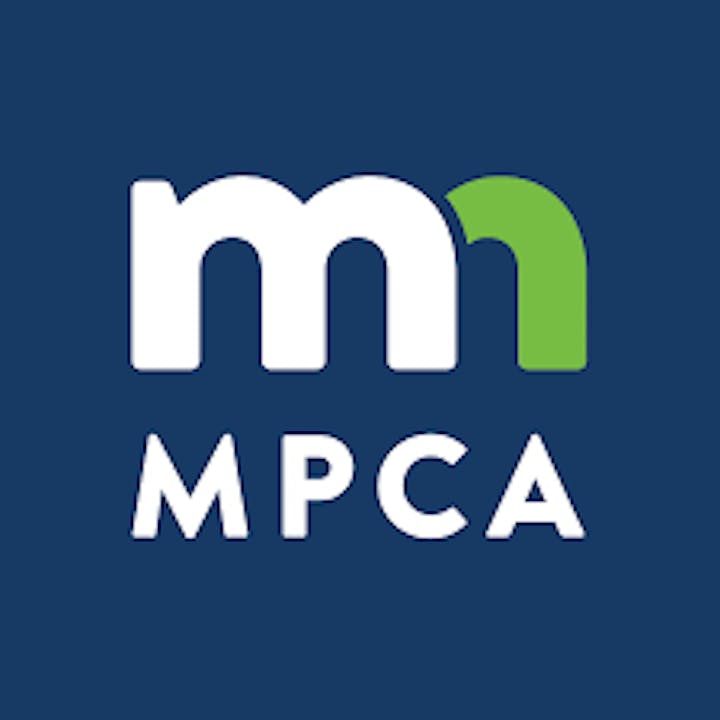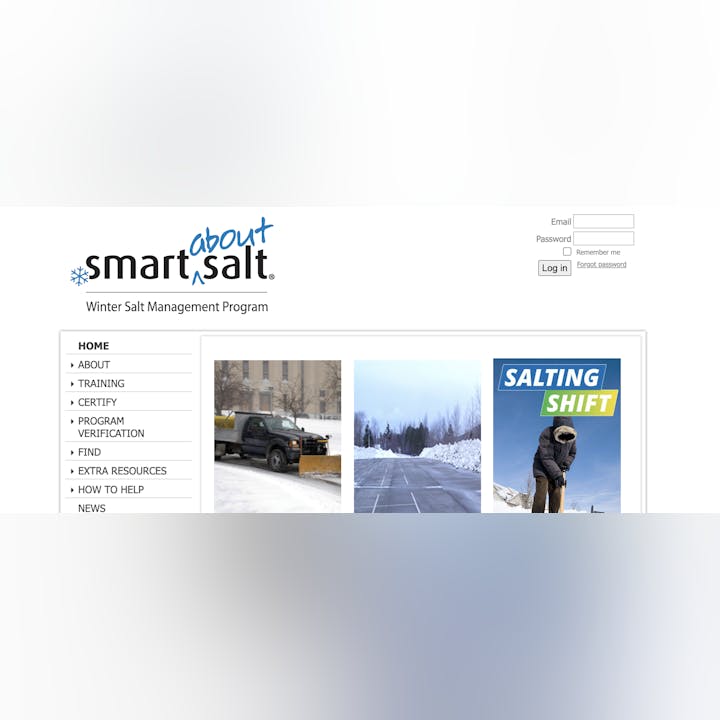low-salt-no-salt
Low Salt, No Salt Minnesota - Content for local government units
This page is intended for local government unit (LGU) staff. If you're interested in learning more, contact your local city or watershed district.
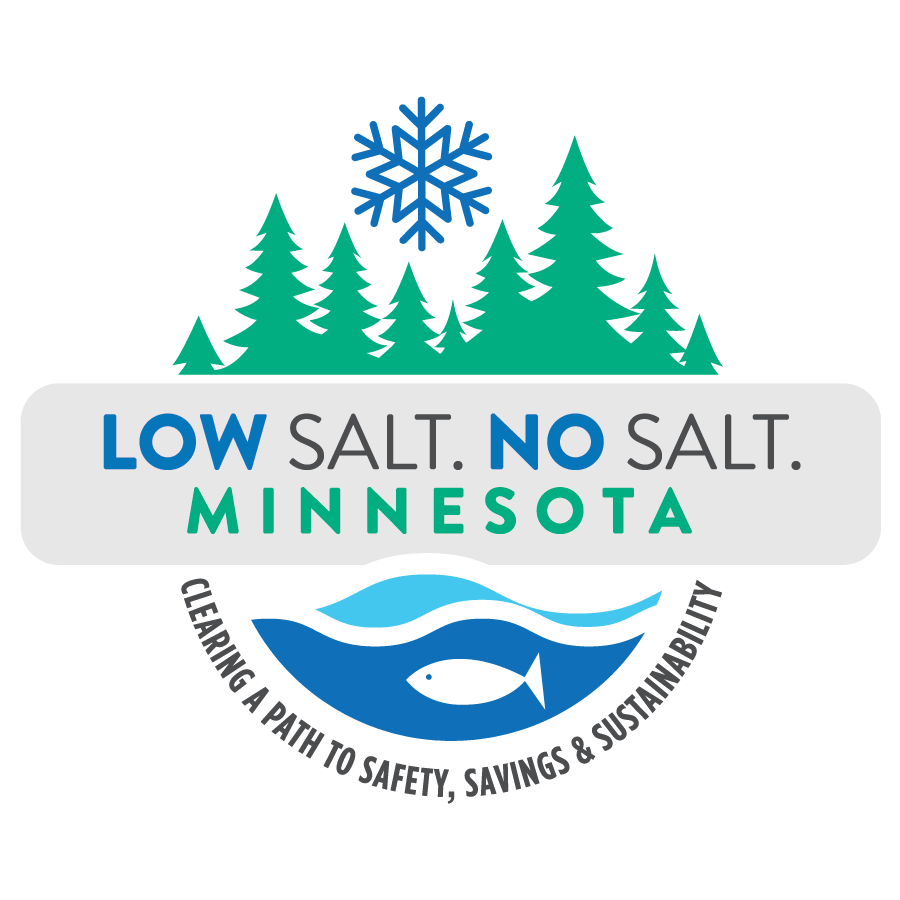

The Hennepin County Chloride Initiative (HCCI) welcomes you to Low Salt, No Salt Minnesota, an innovative new program that builds community capacity to maintain winter safety while reducing chloride-based deicer use and its associated damages through relationships with local properties managed by resident boards. Chlorides from winter maintenance operations are a local problem. University of Minnesota research shows that 3/4 of deicers stay where they are applied, permanently impairing waters for aquatic life and human consumption. They also adversely change soil structure and prematurely age infrastructure. Low Salt, No Salt Minnesota is a research-based program created and tested by professionals from cities and watershed organizations in Hennepin County for implementation by Local Government Units (LGUs) in their communities to build on relationships and ongoing opportunities to provide continued program support. This site is a one-stop mega-resource where you will find customizable resources for your situation.
- The Hennepin County Chloride Initiative, January 2023
We'd love to know who has visited the site, if you're using the materials, and if you have any feedback. Please fill out this form.
See a map of where the program has been implemented. Have you implemented the program in your community? Please fill out this form.
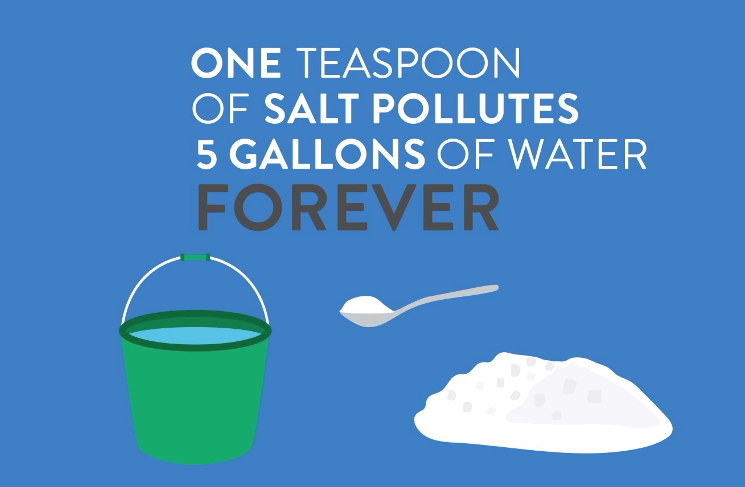
Overuse of de-icers for winter maintenance is a growing problem in Minnesota lakes, ponds, wetlands, streams, and groundwater.
The leading source of chloride pollution is from deicing chemicals (salts) used for winter maintenance. Chloride damages property and the environment, harms aquatic species, and impacts drinking water quality. About 50 waterbodies in Minnesota already have dangerous chloride levels, and another 75 waterbodies are close to the danger zone. Learn more about chloride pollution from the Minnesota Pollution Control Agency (MPCA).
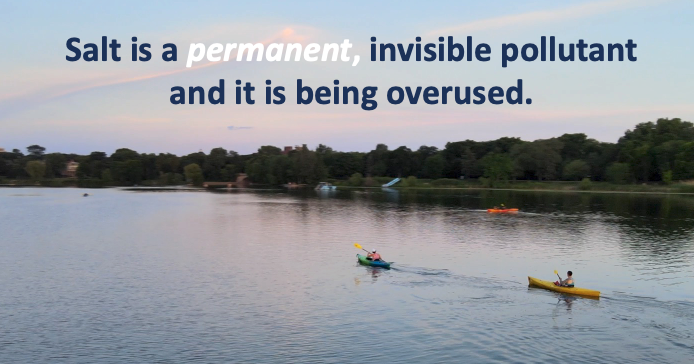
Once chloride is in a waterbody, there is no feasible way to remove it. It takes only one teaspoon of salt to permanently pollute five gallons of water. Further, the alternatives to chloride have other tradeoffs in cost, environmental impacts, and service. Therefore, the leading strategy for managing chloride pollution is to be smart about its use; applying it only when, where, and in the amount needed. This also means that every effort, big or small, helps reduce chloride pollution!
The Low Salt, No Salt Minnesota toolbox is intended for Local Government Units (LGUs) such as cities and watershed management organizations to deliver the program locally, increasing awareness and providing support for private landowners to help them reduce chloride pollution from their properties.

How do we get people to reduce their use of de-icing salts?
Many people believe protecting water resources is important and that education fosters positive attitudes about reducing salt use. But education about chloride pollution, by itself, may not be enough to get people to change their winter salting routines.
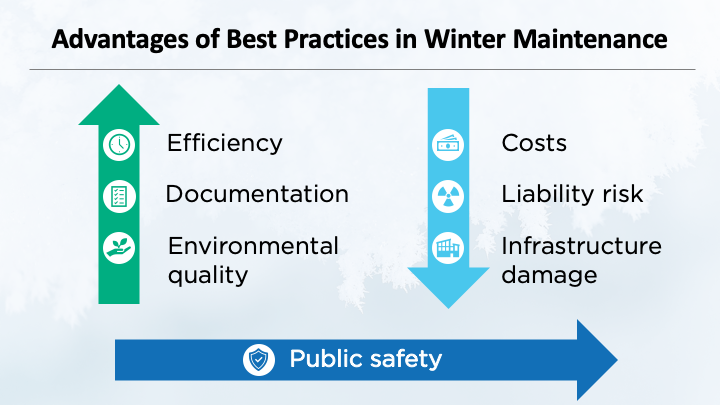
The ability to maintain safety while realizing
financial savings and improving sustainability
are key messages conveyed through this program.
People may be unsure of how best to reduce chloride use on their properties or how to address concerns about safety or liability. You can step into this void by offering a friendly face and simple, site-specific advice. Being the local expert on chloride pollution through the lens of water resources management doesn't mean you have to have all the answers. Cultivating a positive relationship, providing support and encouragement, humbly observing their challenges with winter maintenance, and pointing people to the right resources are the cornerstones of this program. You can play a critical role in guiding local community members to help them clear a path to savings, safety and sustainability.
Our research shows that the biggest driver of over-salting is client demand due to fear of slip and fall lawsuits.
Often, the person applying the salt knows more isn’t better, but they are reacting to their customer’s demand.

Creation of the toolbox
Water resource professionals led the development of and provided expertise for the Low Salt, No Salt Minnesota initiative. The team worked closely with a Minnesota marketing firm to perform interviews, develop a brand, and design materials. The primary goal of the effort was to provide a toolbox that local units of government (LGUs) may use during conversations with local residents, businesses, and property managers about best practices related to winter maintenance.
The Low Salt, No Salt Approach: Direct contact and site-specific advice is an effective way to change behavior related to winter salt use.
How to use the toolbox
You may pull what you need from the toolbox to supplement your existing efforts or start from scratch. Tools such as the PowerPoint presentation are editable, which means they can be customized with your organization's logo and contact information.
Where to begin?
We recommend that you begin by reviewing the "Facilitator Guide." It provides on overview of the Low Salt, No Salt Minnesota program including its purpose, components, and suggestions for implementation.
Low Salt, No Salt Minnesota is a toolbox intended for local government unit (LGU) staff to use in their communities to reduce chloride use. All materials for program facilitation are hosted on this webpage. The facilitator guide provides an overview of the program and suggestions for use.
Download the Facilitator GuideWhat you'll find inside:
- Program overview
- Components
- Getting started
- Key messages
Contacts
Questions, comments, or interested in a facilitator training opportunity? Reach out to one of these contacts:
Jessica Vanderwerff Wilson, Water Resources Manager
City of Edina
jwilson@edinamn.gov
952-82-0445
Liz Forbes, Communications Manager
Riley Purgatory Bluff Creek Watershed District
LForbes@rpbcwd.org
952-607-6481
We are planning a facilitator training in early fall 2025!
Brand style guide
The brand style guide provides typography (fonts), color names, and how to property use the logo. Note about fonts: You should be able to download Brandon Grotesque and Gotham Condensed for free online. You may need your IT department to assist you with adding fonts to your computer.
Brand style guideLogo
There are five color variations of the logo. All are PNG format with transparent background.
Note: White/gray and white logos will not have background color when you download.
Suggested uses
- Consider using the branding style guide when making your own handouts about chloride pollution.
- Add the Low Salt, No Salt Minnesota logos to your website
- Use the logos when sharing chloride pollution information on social media.
Frequently Asked Questions
Your community may have questions about chloride pollution. The Frequently Asked Questions Handout answers some of the most common ones.
Frequently Asked Questions Handout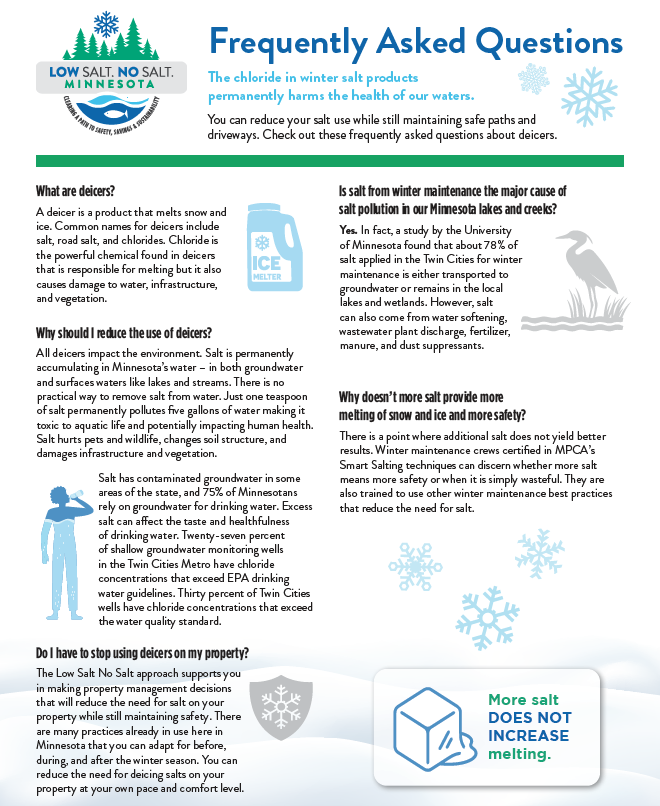
Suggested uses
- Review handout to be prepared for questions.
- Provide handout to community members.
PowerPoint Presentation
Download the Presentation (40 MB)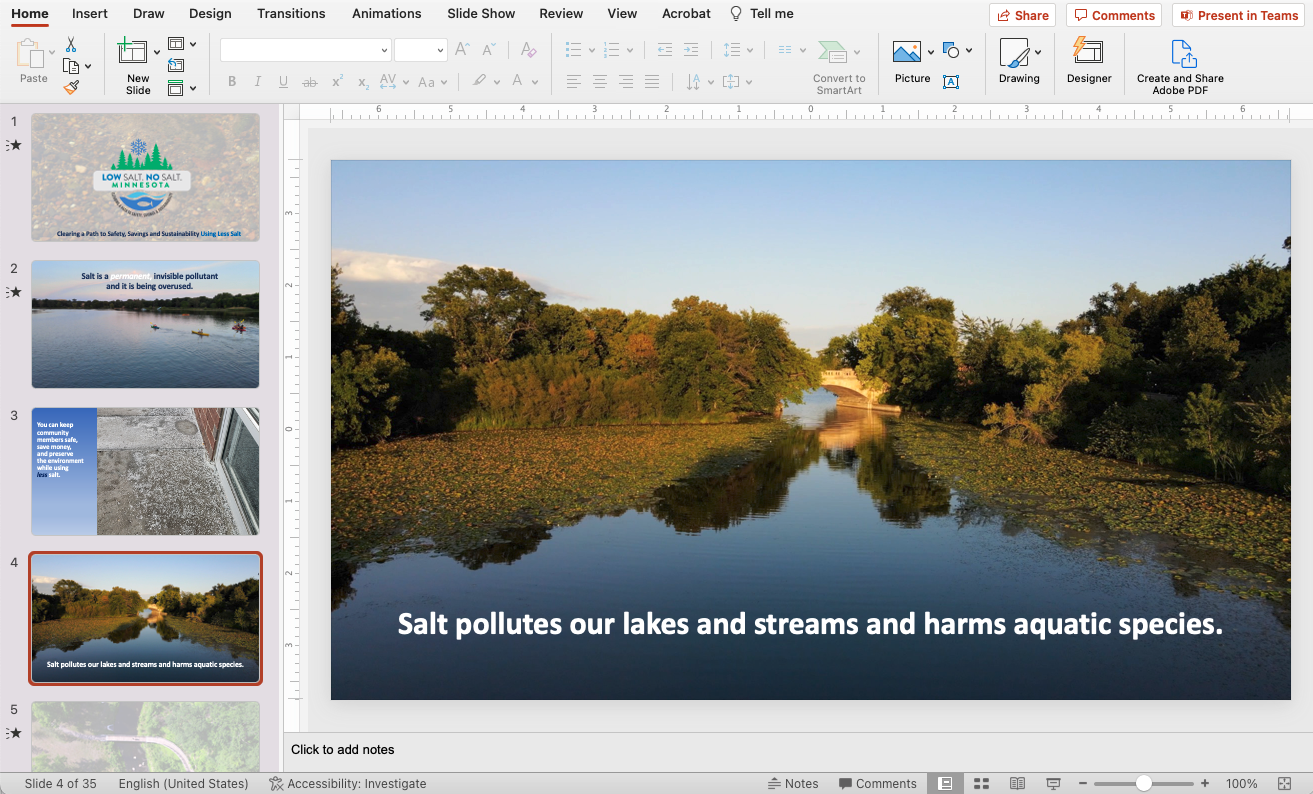
Suggested uses
Customize the presentation for your organization and your audience:
- Add your logo
- Include your contact information
- Add your own slides
- Remove non-relevant slides
Full video (4 min 45 sec)
Social media version of video (40 seconds)
Liability and winter maintenance planning (2 min 34 sec)
Suggested uses
- Share video link with stakeholder through email
- Show video during a virtual or in-person presentation
- Share through social media
- Embed on your website (open video link, click "Share", select "Embed" to view and copy code for inserting onto website
Questions to Begin a Conversation about Reducing Chloride Use
Ice-breaker questions
- Introductions. What is your name, how long have you lived/worked/worshipped here?
- Are you on a board or committee for this place?
- Who has been involved in winter maintenance?
- What do you love about the place where you live/work/worship?
Site assessment questions
- What are your known problem areas? How are you managing them currently? How would you like them to be managed?
- Do you have a written plan with protocols for winter maintenance? If so, are you following the plan?
- Do you hire a service provider or is the service provided by ‘in-house’ maintenance or management staff? If it’s hired out, do you know who your service provider is? Are they Smart Salting certified?
- Tell us about your common areas. Do you have a salt bucket/shovel/ice pick in a common area entrance?
- Is salt stored at your property? Where?
- Do you regularly communicate with your customers/residents/parishioners about winter maintenance operations and snow/ice hazards?
- Do you have a history of slip and fall accidents?
- Where do you get the most complaints for too little or too much salt?
- Do you have any drainage-related problem areas?
- Do you have any snow storage related problem areas?
- Are there any areas that are seasonally closed or could be seasonally closed? (Keep in mind emergency exits)
- What do you think is low hanging fruit for smarter salt use?
- Is there anything you’d like us to see?
General discussion questions
- What’s your reaction to the video? To the presentation?
- What was surprising?
- What did you already know?
- How does this relate to your property?
- What is working well regarding winter maintenance?
- What is not working well regarding winter maintenance?
- Can you think of an example in your community where winter maintenance is done well? Where it could be improved?
Suggested uses
- Use these questions during your presentation or other conversation with someone about reducing use of winter de-icers.
Pledge Form
Download the Take the Pledge form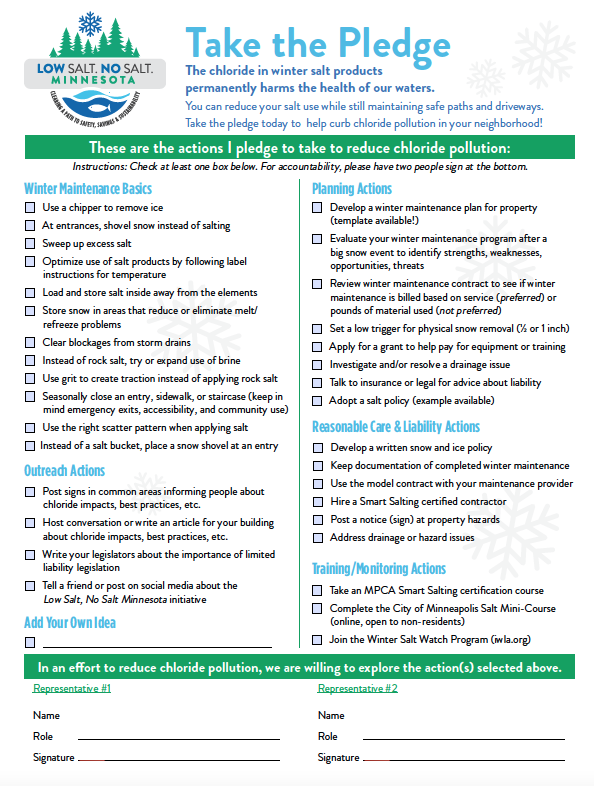
Suggested uses
- Offer the pledge form at community events where you are tabling
- After a presentation related to water quality, ask audience members to sign the pledge
- Email the pledge directly property managers, homeowner associations, and others
Suggested uses
- Mail directly to property or business owner
You can print these cards yourself or send the PDF file to a printing company. The second side has space to add your own contact information or logo.
Download the double two-per-page, two-side card suitable for printing on 8.5"x11" paper or cardstock.Download the single two-sided card. Sized to print at 5.5"x8.5".
Download the single two-sided card with 0.125" bleed. Sized to print at 5.5" x 8.5".
Note: Having a bleed allows extra 0.125" for trimming (color bleeds beyond margin for more finished look) by a professional printing company.
Download EPS versions of the above files on the Low Salt No Salt MN Google Drive. Each image is a separate EPS file labeled "side 1" or "side 2" with descriptor (double, single, bleed).
Front side and back side of card shown below. Back side has space to add your own info or logo.
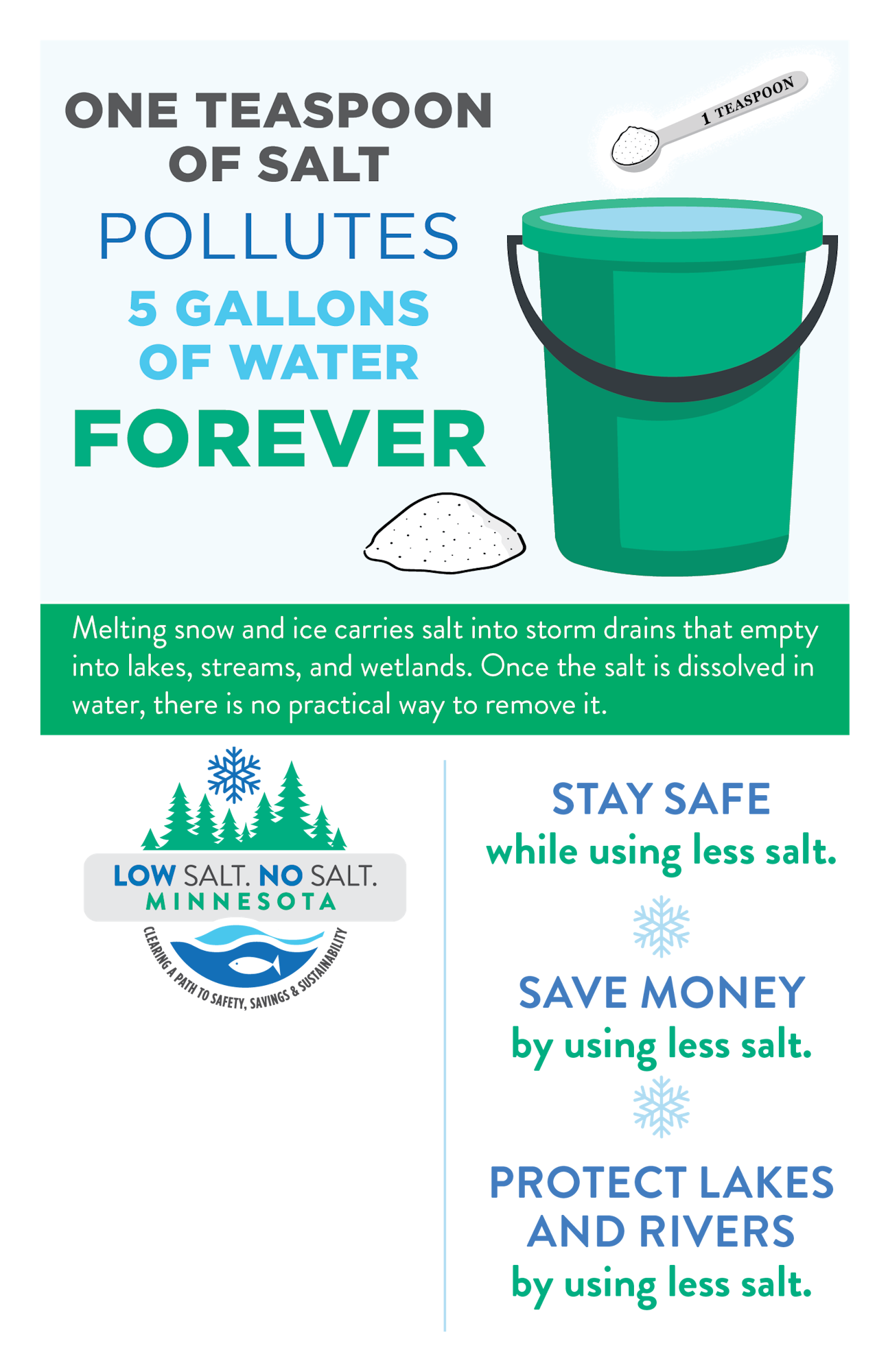
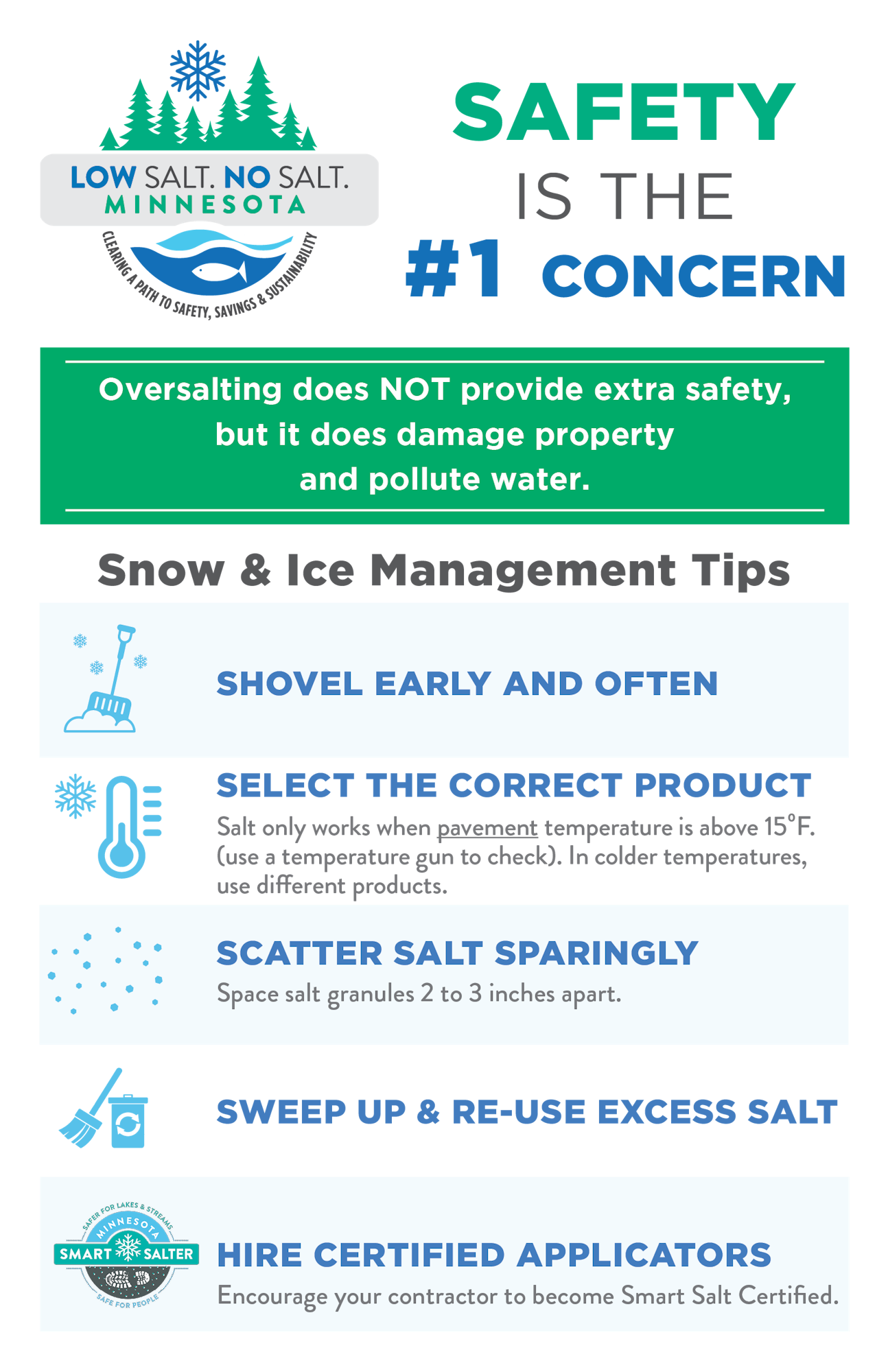
Suggested uses
- Print to have on hand when you're out in the community.
- Handout at events or meetings.
- Use pieces of graphic on social media.
Winter Salt Week is January 27-31, 2025. Check back in fall 2025 for information about Winter Salt Week 2026.
This group of resources is intended to help cities, watershed organizations, Minnesota Water Stewards, and others to spread the word about Winter Salt Week. There's also some resources to help you plan your own Winter Salt Week event.
Help promote Winter Salt Week
Help get the word out about Winter Salt week by sharing a message through social media or email subscriber list or hanging a poster in a public space. Check out these options below.
- Graphic for Winter Salt Week (png, 1080x1080 pixels)
- Winter Salt Week poster (pdf)
- Winter Salt Week Poster (png)
- QR code that directs to WinterSaltWeek.org
Plan Your Own Event
The last day of 2025 Winter Salt Week (Friday, January 31st) is intended for cities, watershed organizations, Minnesota Water Stewards, and others to host a local event to spread awareness about chloride pollution. This can be as simple as a city council recognizing Winter Salt Week through proclamation.
Or you may opt to host and event where you invite the local media and community members to test the chloride level of a local lake, pond, or stream. Consider giving away chloride testing trips to residents to monitor salt levels in their neighborhood waterbody this winter.
Templates and Scripts
- Media release template
- Talking points about Winter Salt Week
- Template for city proclamation recognizing Winter Salt Awareness Week
- Scripts for calling/emailing about Winter Salt Week
Winter Salt Week Activity Packet (Dakota County SWCD)
Staff from Dakota Soil and Water Conservation District developed an activity packet to use during Winter Salt Week 2025 and is generously sharing these materials. Dakota SWCD staff worked with staff from the Dakota County libraries to help spread the word about chloride pollution through use of the materials and library programming. Check out the materials including the activity book, bookmark, button, sticker, and scavenger hunt handout in this Google Drive folder. You can also access the customizable Canva template for the Activity Book. Reach out to Liz Forbes is you have trouble accessing the materials.
Cardboard Snowplow (MnDOT)
MnDOT developed a 3-D snowplow cutout that can be printed and used as an event activity. The design files (Adobe Illustrator) for customization and printing company information are also available. Reach out to Liz Forbes for more information.
External resources
- Request a Salt Watch Kit ⬈ from Izaac Walton League
- Promote MPCA Smart Salting Training ⬈ to winter maintenance professionals
- Help people find their local watershed organization by entering their address on this webmap ⬈.
Questions about content on this page? Contact Liz Forbes, Communications Manager, Riley Purgatory Bluff Creek Watershed District

Low Salt, No Salt Minnesota is an initiative developed in 2022 by the Hennepin County Chloride Initiative (HCCI), a collaboration between multiple watershed districts, watershed organizations, and cities in Hennepin County with support from the county and the Minnesota Pollution Control Agency.
Selecting an Audience

On large developed properties, winter maintenance is typically performed by contractors. When developing an approach for Low Salt, No Salt Minnesota, we wanted to understand if contractors would be a good audience for focusing outreach efforts. Read the full report.
What we found when we interviewed private salt applicators was that they were generally knowledgeable about chloride as a water contaminant. However, their salting practices were primarily driven by client demand and liability concerns. These clients are usually owners and managers of large properties.
Main Message
"When performing winter maintenance, you can maintain safety while realizing financial savings and improving sustainability."
Developing the Messages
By focusing outreach efforts on owners and managers of large properties, we hope to drive demand for contractors that practice smart salting. In developing materials for Low Salt, No Salt Minnesota, we focused on homeowner associations, property managers, and communities of faith. These groups are accessible and tend to make decisions about winter maintenance for large areas including hiring of contractors.
To better understand attitudes and other factors of these groups that affect their willingness to adopt best salting practices, a series of interviews was conducted with these groups. The research revealed group concerns related to chloride use and which messages about reducing chloride use best resonated with them. Review the full market research report.
Creation of the Toolbox
Working collaboratively through the Hennepin County Chloride Initiative (HCCI), water resource professionals led the development of and provided expertise for the Low Salt, No Salt Minnesota program. The team worked closely with a Minnesota marketing firm to perform interviews, develop a brand, and design materials. The primary goal of the effort was to provide a toolbox that local units of government (LGUs) may use during conversations with local residents and businesses about best practices related to winter maintenance. While these materials are useful for a variety of audiences, the targeted audiences for this program include faith-based communities, property managers, and homeowners/townhome associations.
Let us know you were here!
We'd love to know who's visited this site, if you plan to use the materials, or if you have any feedback. Please consider filling out this form.

Model Winter Maintenance Contract
The City of Edina developed a model contract for snow and ice management that embraces best practices to minimize environmental impacts from salt and other chemicals. Property owners can adapt the model contract to suit their needs and to ensure their contractors are protecting Minnesota waters from chloride pollution.
Minnesota Model Contract for Snow and Ice Management (pdf)Cover Letter (pdf)
Explanatory Memo (pdf)
Winter Site Maintenance Templates
Share these with people in your community looking for information about developing a winter maintenance plan. Three templates are scaled to meet user needs:
Basic Winter Maintenance Plan TemplateOr download the Word version insteadIntermediate Winter Maintenance Plan Template (pdf)Detailed Winter Maintenance Plan Template (pdf)
Download the calculator below to help determine which template would be best.
Calculator for Choosing a Winter Maintenance Template
Download the calculator (Excel file) that will help users select a winter site maintenance template.Other Resources
Why reinvent the wheel? There are a lot of great websites out there with resources ready to use in your chloride reduction efforts. Check out these sites.
Do you have a great online resource to share? Please email Liz Forbes.





